D-Day battle sites every American should see as epic invasion fascination draws millions to Normandy
US and Allies stormed Hitler's 'Fortress Europe' in France on June 6, 1944 — here are 12 must-see sites
The quiet beaches and rural villages of Normandy, France, exploded with fire and fury in the early morning hours of June 6, 1944.
D-Day. The climactic battle of World War II.
The United States and its Allies landed nearly 160,000 men, with more than 9,000 killed or wounded, in the first 24 hours alone.
US NAVY, MARINE CORPS JOINED BY IKE, A ‘FACILITY DOG,’ ABOARD USS WASP FOR MENTAL HEALTH BOOST
"The Great Crusade," as it was called by Gen. Dwight Eisenhower, left a lasting imprint on the Norman people and the local landscape.
The epic battle draws an estimated 5 million visitors to Normandy each year. Many of them arrive in early June when the region is alive with festivals, memorials and reenactments celebrating an invasion the French call le debarquement — the landing.
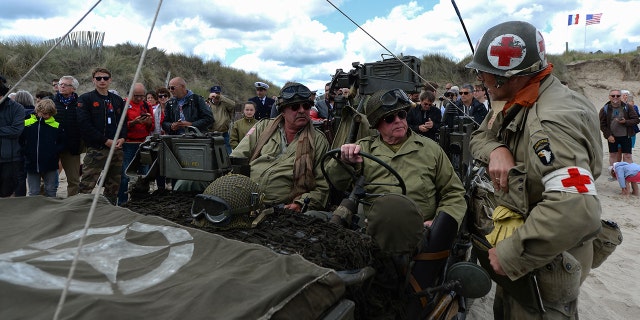
Belgian WWII enthusiasts dressed as soldiers sit in a jeep at Utah Beach, in Sainte-Marie-du-Mont, northwestern France, on June 6, 2019, as part of the D-Day commemorations marking the 75th anniversary of the World War II Allied landings in Normandy. (JEAN-FRANCOIS MONIER/AFP via Getty Images)
D-Day Festival Normandy, an annual celebration hosted by the Normandy tourism board, offers scores of events and ceremonies across the sprawling 50-mile invasion-day battlefield.
It began this year on May 27 and ends June 18.
The Allies landed nearly 160,000 men, with more than 9,000 killed or wounded, in the first 24 hours alone.
Here’s a countdown to 12 D-Day sites every visitor should see to understand the full scope of this "Day of Days."
D-DAY 78 YEARS LATER: HOW FDR'S POWERFUL PRAYER UNITED AMERICANS
 Major battle sites and museums are punctuated by countless private tributes from the citizens of Normandy who express their appreciation for la deliverance in many ways large and small.
Major battle sites and museums are punctuated by countless private tributes from the citizens of Normandy who express their appreciation for la deliverance in many ways large and small. 12 - Iron Mike Memorial

The Iron Mike Memorial outside Sainte-Mere-Eglise in Normandy marks the site of a heroic fight by outnumbered American paratroopers to hold the bridgehead at La Fiere and prevent amphibious landing forces from being slaughtered on Utah Beach. (Kerry J. Byrne/Fox News Digital)
American paratroopers landed soon after midnight on June 6, with the main objective of securing the far western edge of the invasion beachhead for the amphibious landings to follow at sunrise.
The Iron Mike Memorial at La Fiere pays honor to the outnumbered paratroopers of the 82nd Airborne who from June 6 to June 9 heroically repelled repeated German attacks at a bridgehead over the Merderet River.
The climactic bridge battle scene of the fictional film "Saving Private Ryan" was inspired by the ferocious fighting here at La Fiere.
11 - German cemetery at La Cambe

This photo taken on May 29, 2019, shows a general view of a German military cemetery at La Cambe, northwestern France. The D-Day ceremonies on June 6, 2019, marked the 75th anniversary since the launch of Operation Overlord, a vast military operation by Allied forces in Normandy, which turned the tide of World War II, leading to the liberation of occupied France and the end of the war against Nazi Germany. (Damien MEYER/AFP via Getty Images)
The ebullient heroism of many Normandy battlefield sites that pay homage to victorious Allied troops is contrasted by a grim German cemetery just inland from the cliffs of Pointe du Hoc.
La Cambe is the final resting place of 21,000 German soldiers — the identities of many unknown — buried under short, thick, black crosses.
The stark, sober landscape pays testament to the fact that no nation’s youth suffered more under the Nazis than Germany itself. An estimated 200,000 Germans were killed or wounded in the two month-long Battle of Normandy that followed D-Day.

10 - Angoville au Plain
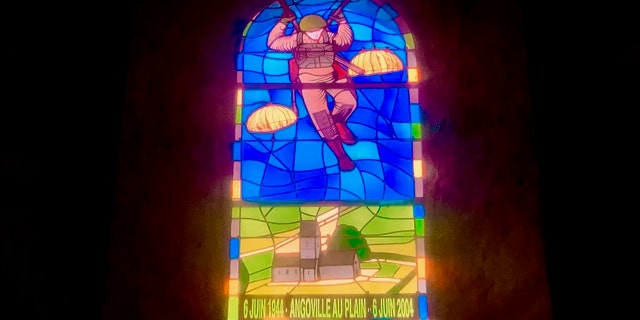
Many Normandy churches honor the heroism of D-Day liberators with stained glass showing paratroopers falling from the sky as if delivered from heaven. This church in Angoville-Au-Plain near Utah Beach served as an aid station manned by medics Kenneth J. Moore and Robert E. Wright. They are created with saving 80 lives over two days of both American and German soldiers as well as treating a local child wounded in the battle around the village. (Kerry J. Byrne/Fox News Digital)
The scope of D-Day is almost too large to fathom.
The tales of individual heroics found throughout the region give the massive battle a human touch.
The tiny village of Angoville-au-Plain is one of those places. Two U.S. Army medics, who landed in the first wave of paratroopers, ended up in this village apparently lost to the rest of their units.
Kenneth J. Moore and Robert E. Wright turned the village's 700-year-old church into an aid station. Over two days, they saved 80 lives of both American and German soldiers; they also treated a local child wounded in the battle.
"U.S. Army medics Kenneth J. Moore and Robert E. Wright turned the village's 700-year-old church into an aid station, saving 80 lives over two days."
They used the pews as beds and several of the benches still bear bloodstains today.
A small cemetery outside the church includes the graves of Americans killed on D-Day.
The heroics of American paratroopers are remembered in the stained-glass windows of churches near the invasion beaches of Normandy, including in Angoville au Plain.

9 - Sainte Marie du Mont/Brecourt Manor
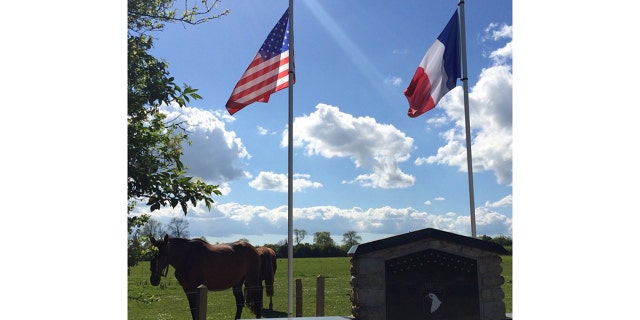
Brecourt Manor near Utah Beach in Normandy was the site of a heroic assault by American paratroopers on D-Day to take out German artillery. The attack was immortalized in the epic HBO WWII series "Band of Brothers." (Kerry J. Byrne/Fox News Digital)
The pretty little village of Sainte Marie du Mont sits just inland from Utah Beach. It housed a German garrison on the morning of June 6.
American paratroopers landed in and around the village to clear and secure a causeway that would allow seaborne raiders to move inland.
In the early hours of the landing, a small group of paratroopers in Sainte Marie du Mont heroically assaulted and silenced four German heavy guns that were firing on the troops on Utah Beach from nearby Brecourt Manor.
The incredible attack is dramatically recounted in the epic HBO miniseries "Band of Brothers." A memorial marks the site today, under French and American flags.
LAST SURVIVING ‘BAND OF BROTHERS’ MEMBER BRADFORD FREEMAN DEAD AT 97
The small cathedral in the center of Sainte Marie du Mont offers images of U.S. troops crammed in for church services on the first Sunday after D-Day, among other haunting reminders of the battle.
8. Carentan/Dead Man’s Corner Museum
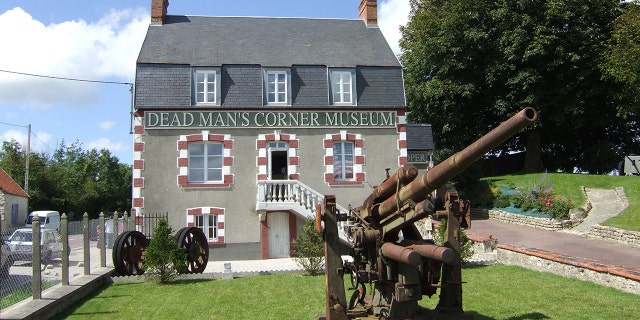
Dead Man's Corner Museum in Carentan, France. (Dukas/Universal Images Group via Getty Images)
Carentan is a small crossroads town on the estuary that separated Omaha Beach to the east and Utah Beach to the northwest.
 The ferocious three-day battle to take the town and link up the invasion forces is portrayed dramatically in episode three of HBO miniseries "Band of Brothers."
The ferocious three-day battle to take the town and link up the invasion forces is portrayed dramatically in episode three of HBO miniseries "Band of Brothers."The building that houses the Dead Man’s Corner Museum was the headquarters of the German garrison defending Carentan on D-Day. It was then taken over as headquarters of the unit of America’s 101st Airborne Division that liberated the town.
The museum gets its name not just from the deadly combat of 1944, but because the building was reportedly haunted even before the war.
7. Bernard Lebrec farmhouse

Bernard Lebrec makes and sells local apple spirits at his family farmhouse near Omaha Beach. His ciderie offers a museum of D-Day artifacts and a monument to U.S. Army engineers who turned the area around the family farm into an aircraft landing strip almost overnight. (Kerry J. Byrne/Fox News Digital)
The main road along Omaha Beach (D514) is speckled with apple orchards and family farmhouses, with distilleries that produce the local specialties: effervescent hard cider and an apple spirit called Calvados. Most offer samples and shops that sell Norman gourmet specialties.
The Bernard Lebrec family farm in Englesqueville la Percee, a short distance from the famous cliffs of Pointe du Hoc, is built into the turrets of an old medieval castle.
MEET THE AMERICAN WHO HONORS THE MEMORY OF 200,000 FALLEN WAR HEROES
Visitors can sample Lebrec’s cider or calvados, scan his collection of World War II memorabilia and stick a pin in one of the maps on the wall that track his visitors from around the globe.

His property — his backyard — also contains a monument to U.S. Army engineers, who turned an adjoining orchard into a landing strip in just three days, helping drive the Allies deeper into Normandy and ultimately onto victory.
6 - Arromanches
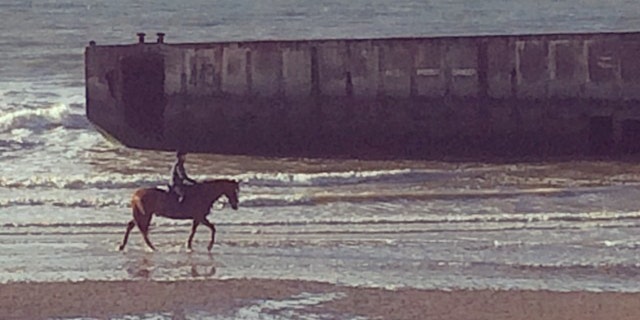
A horse trots along Gold Beach in Normandy, in the British D-Day invasion sector. In the water is a giant caisson, a remnant of a mulberry, one of two artificial harbors the Allies amazingly towed across the English Channel and built almost overnight to assist the invasion. (Kerry J. Byrne/Fox News Digital)
This coastal village on Gold Beach in the British invasion sector is just a couple miles east of deadly Omaha Beach in the American invasion sector.
It’s an ideal spot to take in the scope of the invasion.
Diners at some of the waterfront cafés in Arromanches can see the hulking steel remnants of one of the Allied "mulberries" – artificial harbors towed across the English Channel and erected almost overnight to assist the unloading of the stunning stream of men and equipment that poured into Normandy in the days and weeks that followed D-Day.
Nearby are the German guns of Longue Sur Mer – haunting concrete bunkers that housed artillery that battled with Allied warships on D-Day – and several museums.
The town square of Arromanches is a popular gathering spot for World War II reenactors.
5 - Utah Beach Landing Museum

U.S. veteran Charles Wilson, 90, of Kentucky, poses for a photo next to a sign at Utah beach, in Sainte-Marie-du-Mont, northwestern France, on June 2, 2014. Wilson landed on June 6, 1944, in Utah Beach with the U.S. army's 4th infantry division; this was the first time since that day he'd returned to Normandy. D-Day ceremonies on June 6 mark the anniversary of the launch of the military operation by Allied forces that turned the tide of World War II. (CHARLY TRIBALLEAU/AFP via Getty Images)
Utah Beach marked the far western end of the five British, Canadian and American invasion beaches.
 The beautiful Utah Beach Landing Museum serves as the centerpiece of the many landmarks and monuments that mark the D-Day battle here.
The beautiful Utah Beach Landing Museum serves as the centerpiece of the many landmarks and monuments that mark the D-Day battle here. The museum on a low bluff overlooking the beach is surrounded by numerous other sites, including several devoted to the ships and naval forces that delivered the invaders and ran logistics on the beach during the invasion.
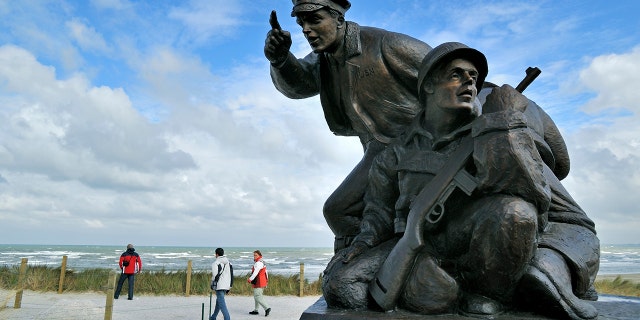
The WWII U.S. Navy D-Day Monument near the Utah Beach Landing Museum at Sainte-Marie-du-Mont, Normandy, France. (Arterra/Universal Images Group via Getty Images)
Among them: the Higgins Boat Monument, dedicated to the iconic landing craft made by New Orleans boat builder Andrew Higgins, the U.S. Navy Normandy Monument and the recently added Lone Sailor Monument.
Café Le Roosevelt, located across the street from the museum, is a popular stop to relax on busy tours and enjoy the taste of Norman fare.
4 - Pointe du Hoc
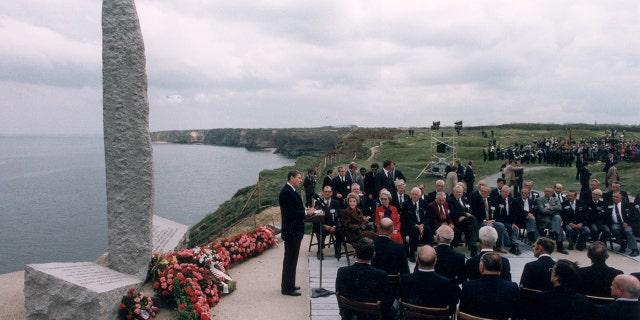
On June 6, 1984, President Ronald Reagan delivered a speech commemorating the 40th anniversary of D-Day, at the site of the Allied invasion, Pointe Du Hoc, Normandy, France. Flowers were laid at the base of the stone memorial by the sea shore. Government officials and World War II veterans sat and listened to the speech. (Ronald Reagan Library/Getty Images)
Pointe du Hoc, a towering cliff between Omaha Beach and Utah Beach, is the site of an incredible assault by U.S. Army Rangers on D-Day.
They scaled the cliffs by ropes and ladders under fire from German defenders to take out a nest of deadly artillery overlooking the invasion beaches.
"When one Ranger fell, another would take his place. When one rope was cut, a Ranger would grab another and begin his climb again," President Ronald Reagan said on this spot on June 6, 1984, in his famous "Boys of Pointe du Hoc" speech, written by White House speechwriter Peggy Noonan.

"They climbed, shot back, and held their footing. Soon, one by one, the Rangers pulled themselves over the top, and in seizing the firm land at the top of these cliffs, they began to seize back the continent of Europe."
The ground atop the cliff is still pockmarked by artillery shells, the remnants of German batteries and monuments to the Rangers.
3 - Pegasus Bridge
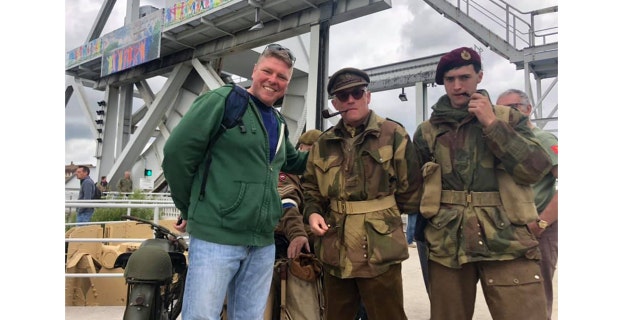
American tourist Frankie Capobianco, left, greets British reenactors at Pegasus Bridge in Benouville, Normandy, on the 75th anniversary of D-Day on June 6, 2019. Pegasus Bridge, named for the symbol of the British 6th Airborne Division, was the site of a heroic assault on German bridgeheads in the earliest minutes of the epic D-Day invasion of France. (Kerry J. Byrne/Fox News Digital)
Nowhere is the dauntless spirit of British invaders on D-Day more evident than at Pegasus Bridge. The heroic attack, led by Maj. John Howard, is legendary in the annals of warfare on both sides of the Atlantic.
Howard’s Ox & Bucks Infantry of the 6th Airborne Division made a daring glider assault, crash landing the aircraft just after midnight, to capture two bridges over the Caen Canal and parallel Orne River.
He reported the successful capture of the two bridges with the code words, "Ham and Jam." The real battle had only just begun: Howard and his unit held off repeated attacks while awaiting seaborne relief.
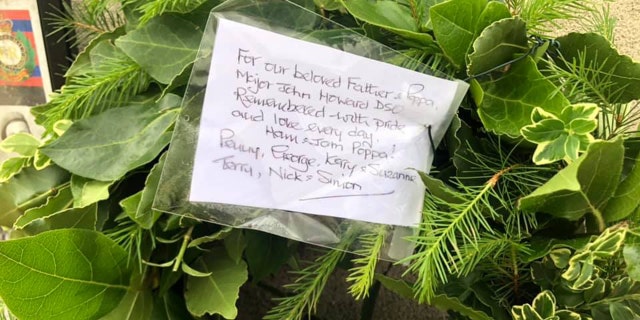
Maj. John Howard led the heroic assault on Pegasus Bridge by British paratroopers on D-Day, calling out the code words "ham and jam" to report his unit secured two critical bridgeheads in Normandy. The phrase "ham and jam" was remembered in a loving tribute to Maj. Howard that his family left at Pegasus Bridge on June 6, 2019, on the invasion's 75th anniversary. (Kerry J. Byrne/Fox News Digital)
The D-Day hero’s family left an incredible handwritten tribute to him at Pegasus Bridge to celebrate the 75th anniversary of D-Day in 2019.
"For our beloved Father and Poppa … remembered with pride and love every day. Ham & Jam Poppa!"

2 - Sainte Mere Eglise
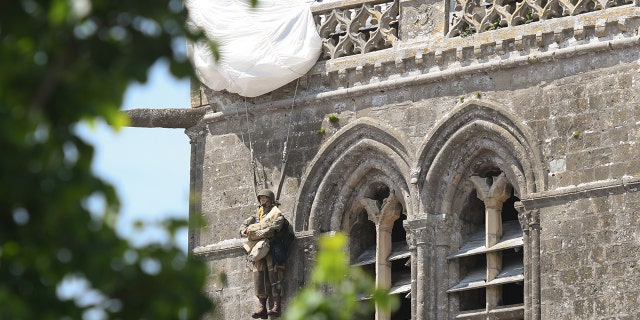
A well-known replica of the U.S. paratrooper, Pvt. John Steele, of the 505th Parachute Infantry Regiment, whose parachute caught on the spire of the Sainte Mere Eglise church. The incident was portrayed in the movie "The Longest Day" by actor Red Buttons. (Artur Widak/NurPhoto via Getty Images)
This village a few miles inland of Utah Beach is celebrated as the first town in France liberated on D-Day and is the center of many celebrations of the battle.
An effigy of American paratrooper Pvt. John Steele hangs in perpetuity from the church steeple in constant memory of the incredible events in the village on June 6.
The horrific scene of D-Day fighting in Sainte Mere Eglise served as the dramatic centerpiece of the 1962 ensemble-cast war epic "The Longest Day" (based on the much better book of the same name by Irish war correspondent Cornelius Ryan).
By sheer coincidence, villagers and dozens of German soldiers had formed a bucket brigade in the town square that very evening to put out a large fire in the center of town – just as American paratroopers began to fall from the sky far from their intended drop zones.

Reenactors from the Netherlands portray American paratroopers in Sainte Mere Eglise, Normandy, to celebrate D-Day's 75th anniversary, June 6, 2019. (Kerry J. Byrne/Fox News Digital)
Many GIs were slaughtered by the German troops who turned their guns to the sky – at least one American died horrifically as he fell into the flames.
Steele was shot as he hung from the church steeple but somehow survived and was taken prisoner. He quickly escaped, found his fellow paratroopers and rejoined the battle.
Steele and fellow U.S. paratroopers remain legendary folk heroes in Sainte Mere Eglise, honored with monuments, street names, museums and an array of tributes.

1. Normandy American Cemetery

The Normandy American Cemetery on a bluff overlooking Omaha Beach in France is one of the world's most famous and most haunting reminders of the cost of liberating Europe in World War II. The remains of 9,368 American soldiers are buried here. The Walls of the Missing include the names of 1,557 troops still missing in action. (Kerry J. Byrne/Fox News Digital)
The American Battle Monuments Commission operates dozens of cemeteries around the world commemorating U.S. war dead and missing in action.
CLICK HERE TO SIGN UP FOR OUR LIFESTYLE NEWSLETTER
Many are larger, but none are more famous, pristine, haunting or hallowed than Normandy American Cemetery Overlooking Omaha Beach, where allied invaders suffered the greatest carnage on D-Day.
Visitors first pass through a museum that gives context to the battle and the meaning of the pristine rows of crosses and Stars of David that line the cemetery; guests can also look up the location of individual soldiers.
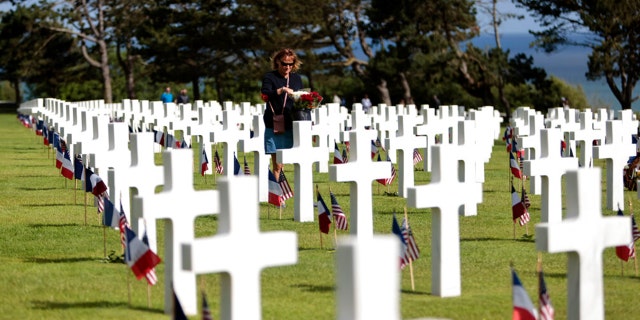
A woman holds a bouquet of roses during the 78th anniversary of D-Day ceremony, in the Normandy American Cemetery and Memorial of Colleville-sur-Mer, overlooking Omaha Beach, Monday, June, 6, 2022. (AP Photo/Jeremias Gonzalez)
The cemetery also highlights the daunting challenge that faced American troops on D-Day.
They first had to cross a vast, wide sandy beach that was littered with obstacles, then make their way up a surprisingly high bluff – all while under withering enemy fire
Visitors today collect sand as a souvenir or splash in the gentle surf that ran red with American blood on June 6, 1944.
No comments: